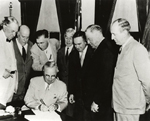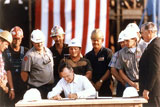
Origins & Evolution of the Department of Energy
 The origins of the Department of Energy can be traced to the Manhattan Project and the race to develop the atomic bomb during World War II. In 1942, the U.S. Army Corps of Engineers established the Manhattan Engineer District to manage the project. Following the war, Congress engaged in a vigorous and contentious debate over civilian versus military control of the atom. The Atomic Energy Act of 1946 settled the debate by creating the Atomic Energy Commission, which took over the Manhattan Engineer District's sprawling scientific and industrial complex. The origins of the Department of Energy can be traced to the Manhattan Project and the race to develop the atomic bomb during World War II. In 1942, the U.S. Army Corps of Engineers established the Manhattan Engineer District to manage the project. Following the war, Congress engaged in a vigorous and contentious debate over civilian versus military control of the atom. The Atomic Energy Act of 1946 settled the debate by creating the Atomic Energy Commission, which took over the Manhattan Engineer District's sprawling scientific and industrial complex.
 The Atomic Energy Commission was specifically established to maintain civilian government control over the field of atomic research and development. During the early Cold War Years, the Commission focused on designing and producing nuclear weapons and developing nuclear reactors for naval propulsion. The Atomic Energy Act of 1954 ended exclusive government use of the atom and began the growth of the commercial nuclear power industry, giving the Atomic Energy Commission authority to regulate the new industry. The Atomic Energy Commission was specifically established to maintain civilian government control over the field of atomic research and development. During the early Cold War Years, the Commission focused on designing and producing nuclear weapons and developing nuclear reactors for naval propulsion. The Atomic Energy Act of 1954 ended exclusive government use of the atom and began the growth of the commercial nuclear power industry, giving the Atomic Energy Commission authority to regulate the new industry.
In response to changing needs in the mid 1970's, the Atomic Energy Commission was abolished and the Energy Reorganization Act of 1974 created two new agencies: the Nuclear Regulatory Commission to regulate the nuclear power industry and the Energy Research and Development Administration to manage the nuclear weapon, naval reactor, and energy development programs.
 However, the extended energy crisis of the 1970's soon demonstrated the need for unified energy organization and planning. The Department of Energy Organization Act brought the federal government's agencies and programs into a single agency. The Department of Energy, activated on October 1, 1977, assumed the responsibilities of the Federal Energy Administration, the Energy Research and Development Administration, the Federal Power Commission, and parts and programs of several other agencies. However, the extended energy crisis of the 1970's soon demonstrated the need for unified energy organization and planning. The Department of Energy Organization Act brought the federal government's agencies and programs into a single agency. The Department of Energy, activated on October 1, 1977, assumed the responsibilities of the Federal Energy Administration, the Energy Research and Development Administration, the Federal Power Commission, and parts and programs of several other agencies.
The Department provided the framework for a comprehensive and balanced national energy plan by coordinating and administering the energy functions of the federal government. The Department undertook responsibility for long-term, high-risk research and development of energy technology, federal power marketing, energy conservation, the nuclear weapons program, energy regulatory programs, and a central energy data collection and analysis program.
 Over its two decade history, the Department has shifted its emphasis and focus as the needs of the nation have changed. During the late 1970's, the Department emphasized energy development and regulation. In the 1980's, nuclear weapons research, development, and production took a priority. Since the end of the Cold War, the Department has focused on environmental clean up of the nuclear weapons complex, nonproliferation and stewardship of the nuclear stockpile, energy efficiency and conservation, and technology transfer and industrial competitiveness. Over its two decade history, the Department has shifted its emphasis and focus as the needs of the nation have changed. During the late 1970's, the Department emphasized energy development and regulation. In the 1980's, nuclear weapons research, development, and production took a priority. Since the end of the Cold War, the Department has focused on environmental clean up of the nuclear weapons complex, nonproliferation and stewardship of the nuclear stockpile, energy efficiency and conservation, and technology transfer and industrial competitiveness.
Today, the Department of Energy contributes to the future of the nation by ensuring our energy security, maintaining the safety and reliability of our nuclear stockpile, cleaning up the environment from the legacy of the Cold War, and developing innovations in science and technology.
Last Reviewed: 3/26/2008
|
 |